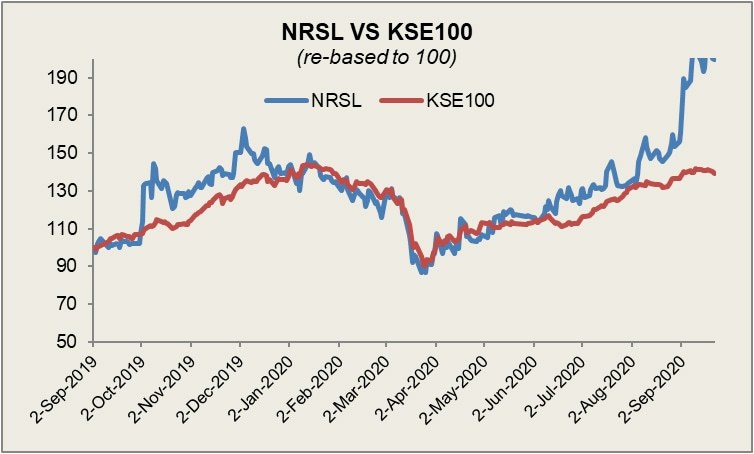Nimir Resins Limited (PSX: NRSL) was established as a private limited company in 1964 under the Companies Act, 1913 (now, Companies Act, 2017). It was later converted into a public limited company in 1991. The company’s ultimate parent company is Nimir Industrial Chemicals while Nimir Resins is a subsidiary of Nimir Management (Private) Limited.
The key operation of the company is to manufacture surface coating resins, polyesters for paint industry and optical brightener and textile auxiliaries for the textile industry. The five business lines under which its product offering is categorized are textile auxiliaries and binders, unsaturated polyester resins, coatings and emulsions, pulp and paper chemicals, adhesives and graphics and trading and exports.
Shareholding pattern
As of June 30, 2019, the company is primarily held by its associated companies, undertakings and related parties with 67 percent shares held under this category. A major shareholder within this is Nimir Management (Private) Limited that holds 51 percent of the shares. About 26 percent of the shares are with the general public while directors, CEO, their spouses, and minor children hold close to 5 percent. The remaining about 2 percent is distributed with the rest of the categories.

Historical operational performance
After dipping in FY15, profit margins peaked the very next year in FY16 for Nimir and since then have been fluctuating. Topline, on the other hand, had been following a declining trend in the early half of the decade, but saw double-digit growth between the years FY17 to FY19 before reducing again in FY20.

In FY15, the company witnessed the highest decline in topline at almost 18 percent. This was due to reduced demand for the products due to the general prevalent macroeconomic environment. The sales volumes saw a little over 18 precent decline. Nimir Resins faces significant competition from the unorganized sector that has emerged in the last decade. Since the unorganized sector is not exposed to the regulatory environment that Nimir Resins faces, the former receives an unfair advantage, creating an adverse impact on Nimir Resins’ financials. Since costs remain intact, the company was unable to cover it with the lower revenue, thereby increasing the loss incurred and a negative 4 percent net margin.
During FY16, the company saw a change in management that was able to turn around the financial position of Nimir Resins. Although topline still declined, it was by a marginal 1.5 percent. The first half of the year saw revenue falling, but when the new management took over in the second half of FY16, it was able to generate revenue enough to post a positive bottomline figure. The new management injected funds into the company that not only reduced the financial expense but also was able to incur capital expenditure. Eventually, Nimir Resins saw a positive net margin of almost 3 percent during the year.

There was a 50 percent incline in topline in FY17. This was due to better sales volumes and better international prices. However, competition from the unorganized sector continued to persist but the new management with its focus on topline growth along with upgradation of plant and equipment and advancing its product range was able to post strong growth. However, gross, and net margins declined marginally year on year with the latter down to 2.8 percent due to a rise in cost of production to 89 percent (FY16: 87 percent) of the revenue. This was due to a significant jump in raw material purchases expense.
There was a 34 percent rise in topline during FY18. This was a result of both, an increase in sales volumes as well as better prices. However, this was also followed by a rise production costs, as a percentage of revenue. This was due to currency depreciation during the year that increased international prices of feedstock. While this created a negative impact on gross margins, net margin slightly improved to 2.9 percent since the company was able to pass on the higher costs to the consumers. In addition, net margin also improved due to company claiming minimum tax concerning previous years.

Growth in industrial sector was adversely affected due to rise in interest rates in addition to significant currency devaluation. Despite such conditions, the company managed to increase sales revenue by a little over 36 percent. This was again attributed to better sales volumes and prices. There was a marginal rise in gross margins as production cost persisted close to 90 percent of revenue. Moreover, there was a notable escalation in finance costs due to higher discount rates and increased business operations. However, this increase was offset my decline in other aspects that allowed net margin to rise slightly to 3 percent.
Recent results and future outlook
Owing to Covid-19 and the resultant strict nationwide lockdown, financial performance of the company in the last quarter was particularly affected as topline nearly halved quarter on quarter. Since the pandemic and the subsequent lockdown occurred towards the end of the third quarter, there was not much change then. The actual effect was seen in the last quarter of FY20. This caused the overall sales revenue for the year to reduce by almost 8 percent. With a negligible decline in production cost as a percentage of revenue, gross margins improved to 11 percent (FY:19 10 percent) while net margin was marred by a persistent rise in finance expense that increased to claim 4 percent of the revenue.
Although the government announced stimulus packages to support the economy, the company foresees tough recovery as there was a reduction in international prices of crude oil and related commodities in the event of the ongoing pandemic.






















Comments
Comments are closed.